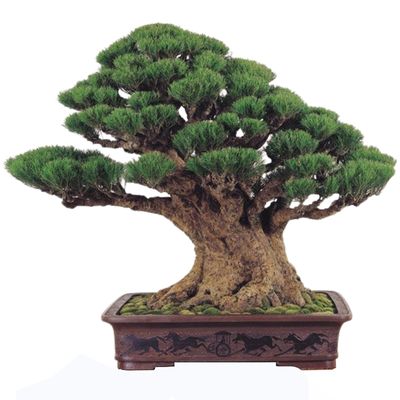
Australian Pine
(Casuarina equisetifolia)
Country of Origin : Australia, south Asia
Bonsai Styles : Informal upright, slanting, clump, multi-trunk, forest
Zone : 9 – 11
Australian Pine (also known as horsetail tree, mile tree, southsea ironwood, she-oak or beefwood) grows along the sandy edges of the constantly humid tropics, from northern Australia to the Pacific islands to southeast Asia.
It is a robust tree, and it looks best when it is cultivated like a pine tree.
The name Equisetifolia means “horsetail leaves”. In nature, the tree grows very tall (almost 25 meters – 82 feet). Because of its natural slender shape and pine-like needles, this tree looks like a pine tree. However, unlike pine trees, it is a deciduous tree.
This is a fast growing tree and produces upright needle-like foliage. The foliage emerges mainly from the upper sides of the branches.
It produces very inconspicuous flowers. It also produces little cone-shaped fruits that are about 5/8 inchs (1.5 cm) in size.
One of the major advantages of growing a Casuarina equisetifolia bonsai tree is that it allows bonsai growers grow a tree with needle-like leaves indoors. (As conifers, like pine, juniper, and others, are cultivated as outdoor bonsai trees).
Please read types of bonsai trees to know about the care instructions of other bonsai tree species.
Best location to keep Australian Pine bonsai tree
In bright light and with plenty of fresh air, Australian pine bonsai does well indoors throughout the year.
It thrives in full sunlight during the summer months.
Temperatures between 50°F and 60°F (10°C and 16°C) with bright light are ideal during the winter months.
If you are living in a place where winters are not that cold, make sure that at least during the night time, the temperature is lowered to between 50°F and 54°F (10°C and 12°C).
IMP: Refer to do bonsai trees need sunlight for more indoor and outdoor bonsai location ideas. Also, refer sunlight requirements for indoor plants for more indoor gardening ideas.
Propagation of Australian Pine bonsai tree
Australian pine can be propagated using seeds or cuttings.
The seeds should be collected after the fruit has matured and dried out. Seeds can then be cleaned and stored until spring, when they can be sown directly into well-drained beds with a coarse sandy texture. If seeds are sealed airtight and kept at 37°F, they can be stored for many years. The seed will germinate in about 2 weeks.
While using cuttings, use mature stems that are still green. You can also use mature stems that have lignified (become brown), but the chances of rooting will be reduced.
Apply rooting hormone to the cutting before planting.
Watering Australian Pine bonsai tree
It is generally recommended to keep Australian bonsai uniformly moist. Too much dry soil will cause the bark to shrink and the plant to die.
You should water it more during periods of hot weather, but don’t over-water as the roots are prone to rotting.
In the winter, the soil should be kept just moist.
Read watering bonsai tree for more details and also about bonsai water immersion technique.
Wiring Australian Pine bonsai tree
Casuarina equisetifolia Bonsai is best wired in early fall, when the twigs have matured.
Read : Detailed guide on How to wire a bonsai. This extensive guide includes all the wiring techniques and Do’s and Dont’s. It will also show you other bonsai training techniques which can be achieved without using wires.
Pruning Australian Pine bonsai tree
When to prune Australian Pine bonsai tree?
How to prune Australian Pine bonsai tree?
When the shoots are well developed, prune back the branches in the spring.
Let the new shoots reach a length of 3 to 4 inches (8 to 10 cm). Now cut these shoots back so that they are not longer than 3/8 inch to 3/4 inch (1 to 2 cm) in length.
Once you are satisfied with the primary and secondary branch ramifications, the second goal is to achieve cushion-shaped foliage on the branches.
As soon as the cloud of foliage is achieved, you can just pinch the shoots and foliage to maintain the shape of the bonsai.
Read how to prune a bonsai to know about the right technique of pruning and more about defoliating a bonsai tree.
Repotting Australian Pine bonsai tree
How to repot Australian Pine tree?
Australian pine bonsai can be repotted every second year. Prune not more than 1/3rd of the total root mass.
Use a bonsai container that is slightly bigger than the total root mass of the tree.
Choose a brown, red, or grey bonsai container that will complement its dark green foliage.
Use a standard free-draining bonsai soil mix.
You can also use sharp sand, loam, and peat moss (or garden compost) in the ratio of 2:1:1.
Please check out how to repot a bonsai to know everything about repotting and root pruning a bonsai.
Must Read: Bonsai Soil Recipes
Must read : Choosing the right bonsai container
Feeding Australian Pine bonsai tree
In the main growth period, from early spring to late summer, use liquid bonsai fertilizer every four weeks. During the winter, do not apply any fertilizer.
Read more about bonsai fertilizer and its application. This will also give you more details on how to feed flowering bonsai trees.
Diseases and pest of Australian Pine bonsai tree
This tree is generally pest free. However, it is susceptible to root rot.
Our comprehensive guide: How to identify and treat bonsai pests and diseases is a great resource for you to see all the organic and inorganic remedies you can use.

